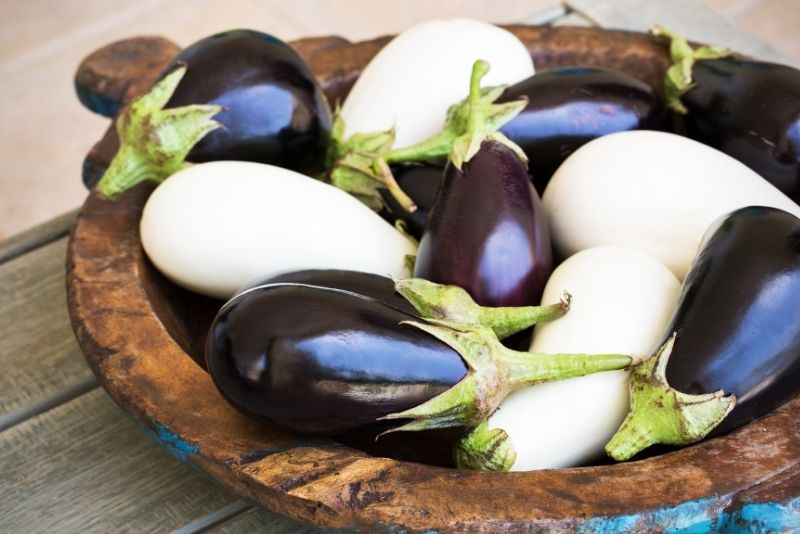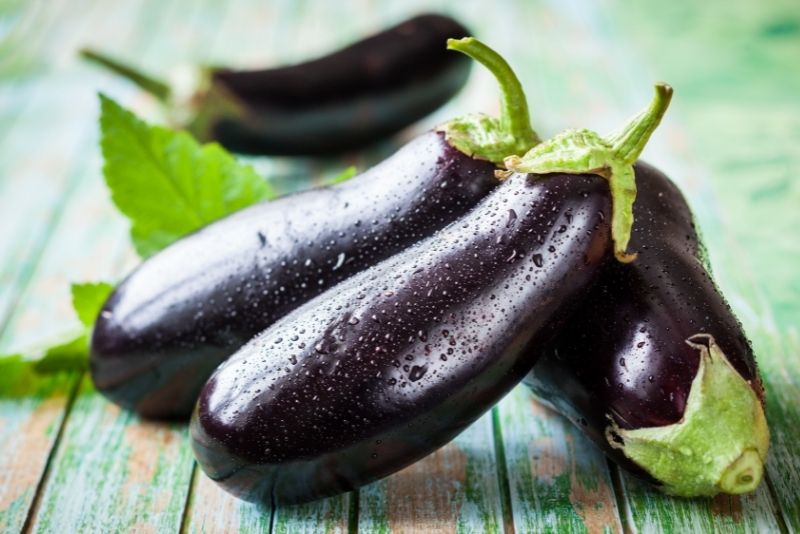Eggplant is a versatile vegetable that can be used in a variety of dishes, from ratatouille to eggplant parmesan.
As someone who loves to cook, I often get asked how to tell if eggplant is bad. If you’re like me, you’ve probably had your fair share of bad eggplant experiences.
You know, the kind where you take a bite and it’s so bitter that your face contorts in disgust. Or, even worse, the eggplant is mushy and flavorless. It’s enough to make you swear off eggplant forever.
To help you avoid that experience, let me share some tips on how to tell if eggplant is bad.
First, look for any bruising or discoloration. It’s also a good idea to check the firmness and weight of your eggplant. If you’re still not sure, go ahead and give your eggplant a smell.
Table of Contents
How to Tell if Eggplant Is Bad?
1. Color
There are many ways to tell if an eggplant is bad, but the easiest way is to check its color. If you see any discoloration or bruising on the surface of the eggplant, then it is probably past its prime and should not be eaten.
A good eggplant also features a dark purple or almost black hue, which indicates that it has developed plenty of antioxidants as it matured.
As a rule of thumb, if your eggplant has a lighter color or one that looks mottled, faded, or spotty, then you should probably throw it away rather than risk getting sick.
Other sign of fresh eggplant includes bright green stems and leaves.
2. Firmness and Weight
In addition to looking at the eggplant’s color, you should also pay attention to its firmness and weight.
A ripe eggplant should have a soft, yet firm texture when squeezed. It should also feel heavy for its size. A bad eggplant will feel mushy when you touch it, and it will be significantly lighter than a fresh one.
If your eggplant feels soft or bruised, then it is probably best to throw it away and look for a fresh one instead.
3. Smell
If you are unsure whether or not your eggplant is good, then you can always perform the smell test. A fresh eggplant should have no odor at all, while an old or bad one will likely have a sour, bitter, or slightly rotten smell.
If you notice any unpleasant smells coming from your eggplant, then it is definitely past its prime and should be discarded.
As you can see, there are many ways to tell if an eggplant is bad. By looking for signs of bruising or discoloration, checking for firmness and weight, and smelling the eggplant, you can be sure to avoid the bad ones and only buy fresh, ripe eggplants.
4. Texture
In addition to its color, smell, and firmness, you can also tell if an eggplant is bad by its texture. A good eggplant should have smooth skin and firm flesh. If the skin is wrinkled or has any cracks, then it is probably past its prime and should not be eaten.
Lastly, if the flesh of the eggplant is slimy, mushy, or spongy, then it is definitely not fresh and should be thrown away.
So there you have it – a few easy tips for how to tell if eggplant is bad. By following these simple steps, you can make sure that your next eggplant dish is as delicious as ever!
How to Cut Eggplant

Now that you know how to select a fresh eggplant, it’s time to learn how to cut it. Eggplant can be tricky to cut, as its flesh is very soft and delicate.
However, with a sharp knife and a little bit of practice, you should be able to master the art of cutting the eggplant in no time.
1. The first step is always to wash your eggplant to remove any dirt or debris that may be stuck to the skin.
2. Then, pat it dry with a clean towel so that it’s nice and dry before you start cutting.
3. Next, cut off the stem of the eggplant. You can do this by slicing it off with a sharp knife or simply breaking it off with your hands.
4. Once the stem is removed, cut the eggplant depending on the shape and how big you want your pieces to be.
Different Styles to Cut Eggplant
1. Diced
Dicing eggplant is a great way to add texture and flavor to stir-fries, curries, or other dishes that use smaller pieces of vegetables.
Slice the eggplant lengthwise into thin strips, then stack the strips and cut them into small cubes.
2. Round
If you want to add large pieces of eggplant to your dish, then cutting it into a round shape is a great option.
To do this, start by slicing off each end of the eggplant. Then, carefully slice the eggplant into even rounds.
Eggplant rounds are great for grilling or roasting, and they can also be added to stews or soups or making eggplant parmesan.
3. Wedges
Wedges are a great way to add both flavor and visual appeal to your dish. They also cook evenly, so you don’t have to worry about any pieces being undercooked or burnt.
To cut the eggplant into wedges, simply slice off the ends and then cut the eggplant into slices. Then, stack a few of these slices on top of each other and cut them into even wedges.
Eggplant wedges are a great option for roasting or grilling, and they can also be added to salads or other dishes.
As you can see, there are a few different ways to cut eggplant depending on what type of dish you’re making or how large you want your eggplant pieces to be.
How to Store Eggplant?
Once you’re done cutting your eggplant, you’ll need to know how to store it properly so that it stays fresh and delicious. There are a few key tips to keep in mind when storing eggplant.
First of all, always keep your eggplant in the refrigerator if possible. This is because eggplant can easily absorb smells from other foods in the refrigerator, so it’s important to keep it in its own space.
If you’re not going to use your eggplant right away, then wrap it tightly in a plastic bag or place it in an airtight container before storing it. This will help prevent moisture loss and mold growth.
Eggplant can also be frozen for long-term storage. To do this, simply wash and cut the eggplant into the desired pieces, then place it in a freezer-safe bag or container.
When you’re ready to use the frozen eggplant, thaw it in the refrigerator overnight before cooking.
Difference Between White and Purple Eggplant

While both white and purple eggplants are delicious and versatile, they come with some key differences.
For starters, purple eggplant is typically larger and firmer than its white counterpart. This makes it ideal for grilling or roasting, while white eggplant is better suited to delicately frying or mashing.
In terms of nutrition, purple eggplants are a good source of antioxidants, while white eggplants are a good source of fiber.
However, white eggplant actually has a slightly different flavor than its purple counterpart. White eggplant is less bitter and has a milder, sweeter taste.
White eggplant is slightly sweeter and softer than purple eggplant. It also has a more delicate flavor, making it a good choice for dishes that are not too heavy or spicy.
Purple eggplant, on the other hand, has a slightly bitter taste and firmer texture. It is also less likely to become mushy when cooked. So if you’re looking for an eggplant that will hold up well in a stir-fry or stew, purple eggplant is the way to go.
Ultimately, whether you choose a purple or white eggplant is a matter of personal preference.
Do You Have to Cut the Skin off From Eggplant?
When preparing an eggplant for cooking, you may be wondering if you have to cut the skin off.
In most cases, no – it’s perfectly fine to leave the skin on when cutting or cooking eggplant. The skin actually contains a lot of nutrients, so it’s a good idea to leave it on if you can.
Final Words
There you have it – some tips for how to tell if your eggplant is bad. If you follow these simple steps, then you should be able to find a great eggplant every time.
Have you ever had a bad eggplant experience? I’d love to hear about it in the comments below.
